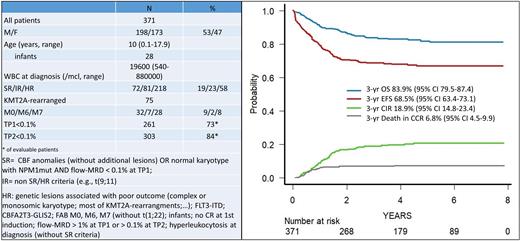Background: Treatment of children with newly diagnosed AML is based on induction therapy, followed by consolidation approaches which differ according to the group of risk patients (pts) are allocated to. In this respect, most treatment protocols stratify pts into 3 risk groups, namely standard (SR), intermediate (IR) and high-risk (HR), mainly based on the molecular/cytogenetic characterization and values of measurable residual disease (MRD) at the end of induction therapy. We report the outcomes of 371 pts with de novo AML other than acute promyelocytic leukemia (aged 0-18) enrolled in the randomized trial AIEOP AML 2013 (EudraCT:2014-000652-28).
Patients and methods: pts were diagnosed and enrolled in the trial from 06/2015 to 06/2022 at 33 Centers affiliated to the AIEOP group. Main pt characteristics and criteria used for stratification are shown in Table 1. A marker of recurrent molecular lesions was detected at diagnosis for 247 cases out of the 371 enrolled (67%). Monitoring of flow-cytometry MRD at the end of the 1 st and 2 nd induction course was centrally performed in all pts but 7. The 1 st induction course was common for all pts (ICE scheme), while, then, SR pts were treated with 4 additional chemotherapy courses, all including high-dose cytarabine (HD-Ara-C). IR and HR pts were randomized to receive either a 2 nd ICE or the FLA-Liposomal Doxorubicin (L-Doxo) scheme as 2 nd induction course. IR pts were given 3 additional consolidation courses including HD-Ara-C with other agents or, in the presence of an HLA-compatible sibling, 1 consolidation course followed by allogeneic hematopoietic stem cell transplantation (HSCT). Pts of the HR group were consolidated with 2 courses of HD-Ara-C combined with other cytotoxic agents and, then, had an indication to receive HSCT from either a donor compatible for > 9/10 HLA loci or from an HLA-partially matched relative. Data cut-off for the analysis was March 31, 2023.
Results: The proportion of pts allocated to the SR, IR and HR groups were 19% (72 pts), 23% (81 pts) and 58% (218 pts), respectively. Overall, 92% of pts obtained morphological complete remission (CR) at the end of the 2 induction courses [as compared to 87% of the previous AIEOP AML 2002 study (Pession et al. Blood 2012), p<0.05]. Twenty-five pts (7%) experienced a primary induction failure. Only 3 pts died during or after the 2 induction courses, while the subsequent cumulative incidence of 3-yr non-relapse mortality in continuous CR was 6.8%. Leukemia recurrence occurred in 63 pts, this leading to a 3-yr cumulative incidence of relapse of 18.9%. With a median follow-up of 4.5 yrs (range 0.8-8), the 3-yr probabilities of overall (OS) and event-free survival (EFS) were 83.9% and 68.5% (Figure 1), respectively, both values being significantly better (p<0.01) than those of the AIEOP AML 2002 study. The 3-yr OS of SR, IR and HR pts were 99.2%, 84.2% and 79.4%, respectively (p=0.01). The 3-yr estimate of disease-free survival (DFS) was 74.3%, with no difference among the 3 risk groups. The EFS did not differ in IR and HR randomized to receive either a 2 nd ICE or the FLA-L-Doxo scheme as second induction course. Levels of flow-cytometry MRD after the 2 nd induction course strongly influenced the probability of EFS which was 76% and 48% in pts with an MRD value < or >0.1%, respectively (p<0.01). Allogeneic HSCT was performed in 160 pts; in these pts, the 3-yr probabilities of OS and DFS were 87.7% and 85.1%, respectively, with no difference according to the type of donor employed. The DFS of the 10 IR pts given HSCT was 100% as compared to 72.1% of the 71 not transplanted (p=0.07). The outcome of infants treated in this study was particularly good, since their 3-yr probability of EFS was 78.3%. The 3-yr EFS of the 35 pts with FLT3-ITD and of the 75 with KMT2-A rearrangements were 57.1% and 64.7%, respectively.
Conclusions: These results indicate that in children enrolled in the trial AIEOP AML 2013 the 3-yr OS and EFS overcomes 80% and approaches 70%, respectively, with a significant improvement as compared to the previous AIEOP protocol. Disease recurrence/primary resistance were the main cause of treatment failure, while the probability of DFS did not differ among the 3 different risk groups, this finding indicating that tailoring of consolidation therapy according to the risk profile was successful in improving the outcome of pts with worse prognostic characteristics. The use of FLA-L-Doxodid not offer any advantage over repeating a 2 nd ICE.
Disclosures
Rizzari:CLINIGEN, JAZZ, SERVIER, SERB: Consultancy, Honoraria, Speakers Bureau. Fagioli:Bluebird: Speakers Bureau; Astellas: Speakers Bureau; Takeda: Consultancy; Bayer: Consultancy; Amgen: Consultancy, Speakers Bureau; Novartis: Consultancy; Medac Pharma: Consultancy, Speakers Bureau; Eusa Pharma: Consultancy; Iqone (Clinigen): Consultancy; Gilead: Consultancy. Lo Nigro:Novartis: Consultancy, Membership on an entity's Board of Directors or advisory committees; Clinigen: Consultancy, Membership on an entity's Board of Directors or advisory committees; Amgen: Consultancy, Membership on an entity's Board of Directors or advisory committees; Jazz Pharmaceutical: Consultancy, Membership on an entity's Board of Directors or advisory committees. Merli:JAZZ: Consultancy, Honoraria; SOBI: Consultancy; MEDAC: Speakers Bureau; Amgen: Speakers Bureau.


This feature is available to Subscribers Only
Sign In or Create an Account Close Modal